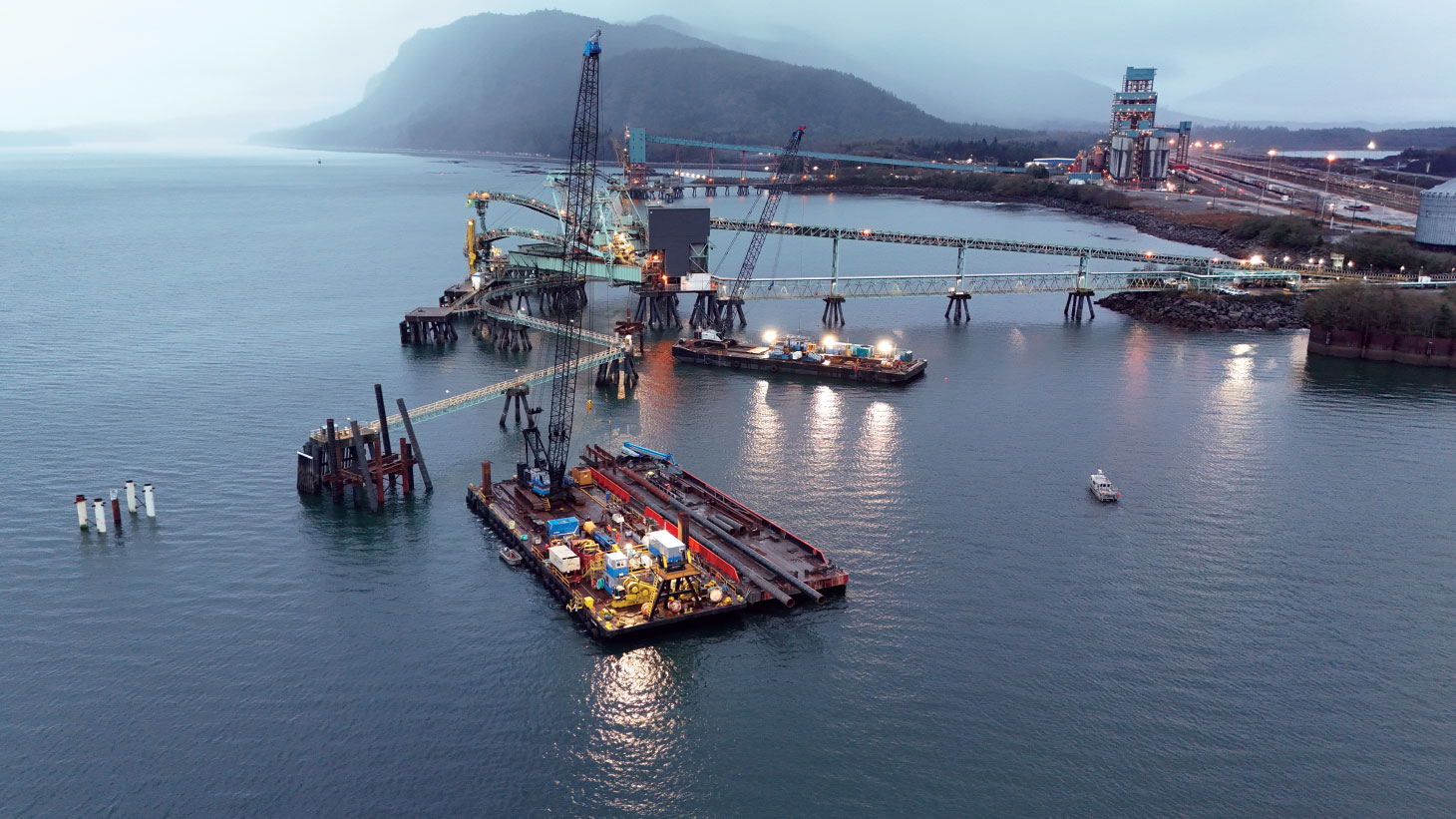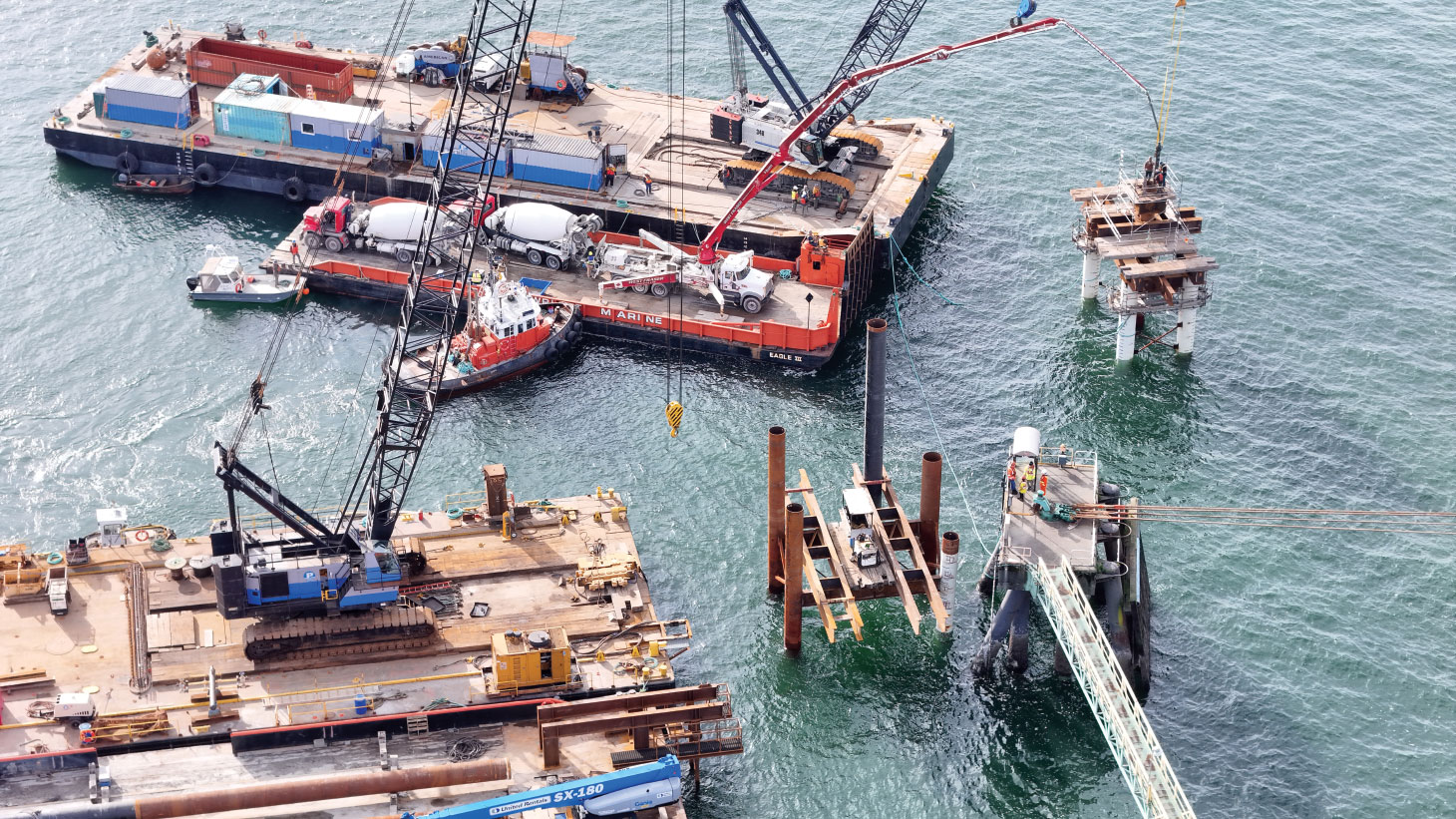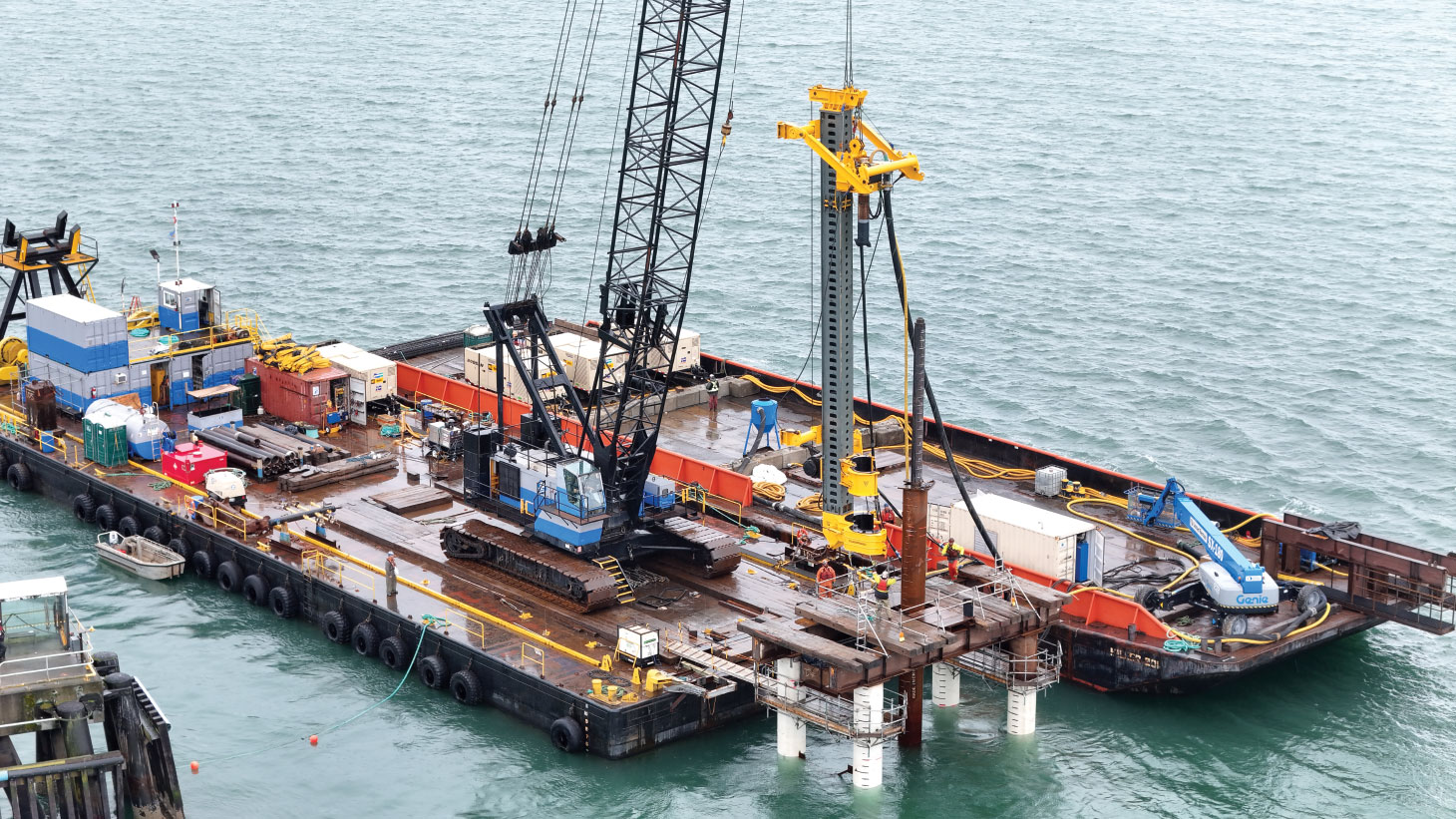
Trigon Pacific Terminal’s Berth 2 Beyond Carbon (B2BC) project at its Prince Rupert, B.C., facility will nearly double terminal capacity with a new berth dedicated to low carbon energy exports.
Supported by a $75 million federal government grant through the National Trade Corridors Fund, construction for the project began in December 2022 with marine works scheduled for completion by the end of 2024.
“This project represents a ground-breaking endeavour in Canada’s infrastructure landscape,” said Simon Munneke, director of operations at PPM Civil Constructors (PPMCC). “Serving as the nation’s first purpose-built facility in Western Canada for handling low carbon energy exports, it stands poised to revolutionize the Canadian energy export sector.”
“PPMCC aims to not only achieve its objectives but also set a benchmark for the marine construction industry.”
Simon Munneke, PPM Civil Constructors
PPMCC was awarded the contract by Trigon for the marine construction scope and owns robust equipment, essential for executing such a large-scale project.
“Specifically, we have deployed a barge equipped with a 450-tonne crane dedicated to piling activities, while a second barge features a 300-tonne crane for drilling operations,” said Munneke. “Our drilling capabilities are further enhanced by a custom-built leads system paired with a rotary top drive, tailored to accommodate various pile configurations. For piling activities, we use two hammers, an [American Piledriving Equipment] diesel hammer and a Junttan hydraulic hammer. Additionally, we maintain an additional 450-tonne crane within our logistics yard to facilitate pile splicing and material loading tasks efficiently. This comprehensive equipment suite underscores our commitment to delivering high-quality results on projects of significant scale.”
Situated southeast of the existing Berth No. 1, the construction and marine work involve the development of several key structures for Berth No. 2, including:
- North and south berthing platforms, each designed to accommodate future tower ship loaders for bulk solid ship loading
- Centre loading platform
- Two north mooring dolphins, with plans for future infrastructure support
- South mooring dolphin
- Dolphin access catwalks and stop dolphins
- Access trestle and roadway structures supporting topside piping and infrastructure
- Access trestle platform and connecting platform
- Marine foundations for future bulk solids conveyor
- Navigation aids and mooring systems
- Artificial reef
- Grounding and bonding measures
“With the completion of piling works for the south mooring dolphin, south platform and loading platform, significant progress has been made on the project,” said Munneke. “Currently, drilling activities are underway on the south platform, marking another milestone in the project’s development.”
Static load testing for the project was conducted through adhering to standardized procedures. PPMCC used advanced instrumentation, including strain gauges, hydraulic jacks, load cells and displacement transducers, to measure and control accurately during the testing process. Simultaneously, a specialized datalogger logged the data collected from these instruments, ensuring precision and reliability. Based on the results of the test, there was a requirement to change the rock socket depths on a few piles due to the variability in the geotechnical conditions.
The project entails the installation of piles, some of which extend up to 81 metres long, the majority of which have drilled rock sockets, says Munneke.
“These piles are driven into the bedrock to create a secure foundation, requiring subsequent drilling to accommodate rebar and concrete,” said Munneke. “Notably, the longest rock socket on the project measures approximately 9.5 metres, posing a compelling construction challenge for PPMCC due to the varying bedrock elevations, socket depths and rock quality. Adding to the complexity, the piles exhibit a range of inclinations from vertical to 1:3 batter, necessitating careful design considerations for the falsework used during pile driving operations. Proximity to the existing structure presents additional challenges, requiring precise planning to avoid clashes during pile driving activities.”
Minimal project footprint
The project operates within a robust environmental management framework, adhering to guidelines set forth in government regulations with permits secured for critical activities such as pile driving and waste management.

Compliance with stringent regulations, including those for noise control and solid waste management, underscores the project’s dedication to responsible development.
“At the federal level, adherence to legislation such as the Canadian Environmental Protection Act and the Fisheries Act ensures that environmental impacts are minimized and mitigated,” said David Garcia, PPMCC’s project manager. “Similarly, provincial regulations provide additional layers of oversight, guaranteeing that the project meets high environmental standards.”
Central to the project’s approach is the implementation of a construction environmental management plan (CEMP). This plan outlines specific environmental monitoring and reporting requirements, enabling real-time assessment and mitigation of potential environmental risks during construction. Addressing concerns such as habitat preservation, marine species protection, water quality and noise abatement, the CEMP ensures that the project’s footprint remains as minimal as possible.
“We view [this project] as an opportunity to showcase our expertise in marine civil construction and environmental management while contributing positively to the community and the environment.”
Simon Munneke, PPM Civil Constructors
“Furthermore, waste management practices are carefully outlined to uphold sustainability standards,” said Garcia. “The project maintains transparency and accountability by keeping all permits, licenses and approvals onsite, accessible to staff and regulatory authorities. Electronic distribution of these documents ensures that all stakeholders remain informed and engaged throughout the project life cycle.”
Risk assessment and regulatory compliance
“Given the project’s magnitude and intricacy, stringent safety protocols have been paramount to safeguarding the well-being of the workforce,” said Lindsay Langill, PPMCC’s director of people and strategy. “The establishment of a safe working platform began with thorough site preparation and implementation of robust safety protocols. Our team ensures that all workers are equipped with appropriate personal protective equipment and received comprehensive training in safety procedures. Continuous supervision and monitoring have been maintained to enforce adherence to safety protocols, with regular inspections conducted. We have fostered a culture of continuous improvement, actively encouraging workers to report hazards and share insights for enhancing safety performance.

“Through these measures, PPMCC has provided a safer environment for all workers involved in the project, safeguarding their health and well-being while achieving project objectives.”
To uphold the highest construction standards and guarantee the longevity of the infrastructure, PPMCC instituted rigorous quality control measures, involving a regime of regular inspections, thorough material testing and adherence to design specifications.
“The project remains committed to regulatory compliance, ensuring adherence to all relevant regulations and permits,” said Munneke. “By upholding these standards, PPMCC aims to not only achieve its objectives but also set a benchmark for the marine construction industry. As the prime contractor of the Trigon B2BC project, PPMCC is deeply honoured and enthusiastic about our involvement in this significant endeavour. We recognize the project’s scale, complexity and potential impact, and we are committed to delivering it with the highest standards of excellence and professionalism.”
“Compliance with stringent regulations, including those for noise control and solid waste management, underscores the project’s dedication to responsible development.”
David Garcia, PPM Civil Constructors
The PPMCC team has been collaborating with all stakeholders involved, including regulatory agencies, local communities, Indigenous nations and environmental experts.
“Being part of such a prestigious project aligns perfectly with our company’s mission and values,” said Munneke. “We view it as an opportunity to showcase our expertise in marine civil construction and environmental management while contributing positively to the community and the environment. We are fully committed to upholding all regulatory requirements, ensuring environmental protection, building long-term community relationships and fostering open communication throughout the project’s duration. Moreover, we are dedicated to implementing best practices in project management, safety and quality control to ensure that the Trigon B2BC project is completed safely, efficiently and to the satisfaction of all stakeholders.”